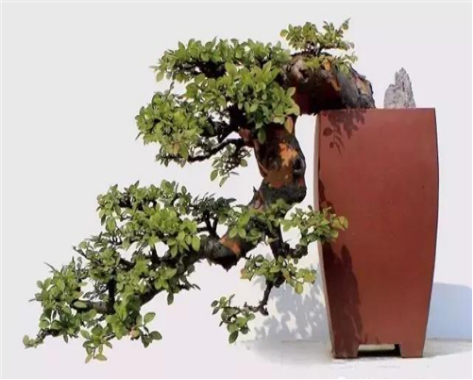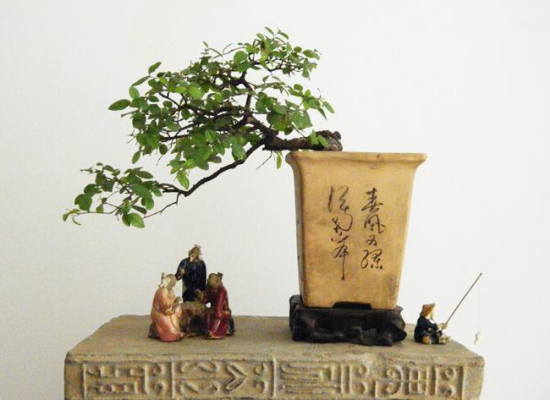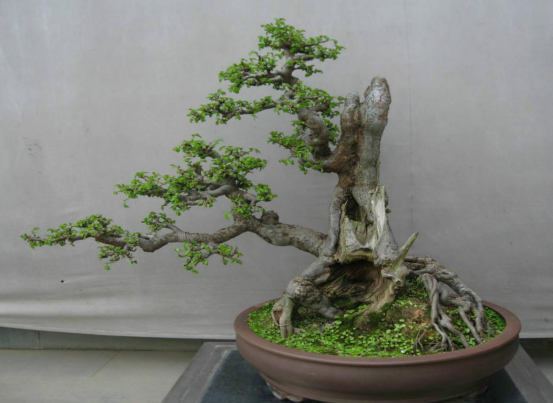The making process of Elm Bonsai
Step 1: prune the root branches
We must first prune the branches and roots before planting. The aim is to make it easier to grow and grow better.
Step 2: deal with the cutting place
Because there is often sticky sap flowing out of the cuts of elm trees. If the elm exudates too much liquid, it will seriously threaten the health of the elm, and even lead to the death of the elm. So we can seal the cut with wax or paint, or we can put a layer of sulfa ointment or erythromycin ointment on it, and then sprinkle the ointment with fine sand.
Step 3: compaction and watering
After we plant, we should compact the soil as much as possible. The newly planted elm trees do not need to be watered immediately, we just need to spray water evenly on the branches 1-2 times a day, and then water them again after 3-4 days. After that, as long as the soil is not dry, do not water, absolutely can not let the soil accumulate water.

Step 4: styling
First of all, we have to choose the time to do styling. The editor suggests that it can be done in the dormant period or growing period after falling leaves, but we must avoid the budding period, because pruning will do some harm to elm trees at this time. After our skillful hands and careful pruning and banding, we can make elm into many different forms of bonsai, such as qu dry type, water-facing type, stone-attached type, oblique dry type and so on.
Production process and maintenance methods of Elm Bonsai
The following is an article about the production process and maintenance methods of elm bonsai introduced by Flower Bonsai Network.
Elm, deciduous trees, up to 25 m high, with a globose crown. The bark is grayish black, longitudinally split and rough. Branchlets gray, often arranged in two rows. Like light, cold resistance, drought resistance, not resistant to water and moisture. Can adapt to dry and cool climate; like fertile, moist and well-drained soil, it can also grow faster in dry, barren and light saline-alkali soil.
Elm trees, especially the old piles that grow in the wild, have gradually formed many different strange gestures after years of man-made chopping axe chisels, or wind and rain erosion, animal bites and so on. Some are intertwined, vigorous and simple, while others turn decay into magic, withered roots and new leaves, unique caves, and are excellent materials for making bonsai.
1. Elm tree making program
Here is a brief introduction to the process to be carried out in the production of elm bonsai:
The old piles of elm trees that have just been excavated should be planted in plain sand or planted in tile pots to "raise piles". It is generally carried out from late autumn to spring (the survival rate is the highest in the two or three months before sprouting). Before planting, the roots and branches should be pruned first, and the viscous sap often flows out at the cut. If the liquid exudates too much, it will seriously affect the survival rate. Use paint, wax seal in the cut, you can also apply a layer of erythromycin ointment or sulfonamide ointment, and then sprinkle with fine sand. Compact the soil as much as possible after planting, but do not need to water, just spray clean water to the branches 1-2 times a day, and water again 3-4 days later. It is forbidden to accumulate water in the soil if it is not dry or watered in the future.
Secondly, according to the basic shape of the old pile, the elm bonsai should be made into different forms of bonsai, such as straight dry type, curved dry type, oblique dry type, water-facing type, cliff type, wind type, jungle type, stone-attached type and so on. Modeling time can be in the dormant period after falling leaves, but also in the growing period, but to avoid the budding period.
Second, conservation of elm bonsai
The molded elm bonsai is planted in a small basin such as purple sand basin before germination in spring, and sand with loose air permeability, good drainage and rich humus should be used.
Planting in qualitative soil. It is usually maintained in a place with good ventilation and sufficient light to keep the basin soil moist without stagnant water. When it is hot and dry in summer, it can sprinkle water on the ground around the plant, but it is not suitable to spray water directly to the leaf surface, so as not to make the leaf bigger and lose its sense of beauty. Apply mature rarefied liquid fertilizer every 20 days or so.
The germination of elm is very strong, growing fast, the growing season should be often pruned, cut off too long, disorderly branches, in order to maintain the beauty of the tree. The best viewing period of elm bonsai is when the new leaves are just coming out, if all the leaves are removed in the first and middle of August, and the management of water and fertilizer will be strengthened later, new leaves will grow again in late September to improve the ornamental value. Winter moved to the bright cold room, can also be buried into the outdoor leeward sunny soil, reduce watering, so that the plant fully dormant. Turn the basin every 2-3 years during maintenance to make the bonsai grow exuberantly and full of vitality.
Key points for the conservation of elm bonsai
1 like the light to bear shade a little, avoid the sun in summer and autumn, and water more
It can be pruned all year round, but not in rainy days to prevent dripping and withering branches.
(3) the humus mixed soil of PH5.5~6 is suitable.
(4) from April to October (except for mildew and rain), thin book organic fertilizer or cake fertilizer and water were applied every 15 to 10 days. When nitrogen, phosphorus and potassium are used in combination, urea is sprayed on the leaves about 2 days after pruning. About 10 days before entering the room in winter, organic fertilizer or cake fertilizer water mainly composed of phosphorus and potassium fertilizer is poured once, and cake crumbs are applied once after entering the room.
(5) during the growing period of pruning, the fine branches and cross branches are often pruned.
6 diseases and insect pests were sprayed with 1500 times of 80% dichlorvos or 2000 times of wind and lightning to kill golden flower insects, shell insects and longicorn beetles.
How to make Elm Bonsai into a pile Landscape of Elm Bonsai by dry cutting
Elm belongs to Ulmaceae, deciduous trees, leaves alternate, small and dense, thick and hard, turquoise, rough, fresh and tender leaves are particularly lovely. Blossom and bear fruit in March, the fruit is named Yu Qian. It is yang-loving, slightly shady, suitable for warm and humid climate and semi-dry soil, strong adaptability, can withstand cold, drought, barren, sun. Usually watering should be sufficient, but no stagnant water is allowed. Strong germination, resistance to pruning, flexible branches, easy to tie shape, is an ideal good bonsai material.
The use of large trunk cutting propagation of elm is easy to take root and form quickly, which is a good way to obtain large ideal elm pile scene. Now share the practice and experience of Hua you as follows:
Every year, Lesser Cold chooses a graceful trunk from the perennial elm and intercepts it. According to the needs of modeling, cut off the branches that affect the appearance, leave one or two branchlets at the top, but cut them short, then gently break the surface close to the cross section (so that the root system can come out of the injury), soak it in the rooting agent solution for a period of time, and then bury it on the seedling bed or planted on the ground.
The inserted pile should be well ventilated, sunny and facing south, and the soil should be permeable and breathable. Cinder and plant ash can be added to the soil to facilitate water permeability and air permeability. When cutting, the soil around the cuttings is compacted and the right to use the cuttings is closely connected with the soil, and covered with a plastic film bag to pour enough water. In the future, keep the soil moist, remove the bag and spray water on the cuttings sooner or later. Avoid the sun during the day and let the branches come into contact with dew at night. A month later, the bud appears, take root and sprout leaves, wait for the bud to grow to 5 years or so, you can remove the membrane bag, but to shade. After a week, the formation of new branches, can gradually increase light, and even full sunlight, increase photosynthesis to promote branch and leaf growth and root development. In the future, strengthen fertilizer and water management, apply rotten farm manure every 10 days after normal growth, in order to facilitate growth, increase branches, but also control diseases and insect pests, choose branches to erase excess branches and buds, correct tree potential, and allow them to develop freely in the future.
Unearthed in March of the following year, cut off the useless branches, straighten out the root system, highlight the lateral roots and plate roots, and at the same time cut the strong and help the weak (cut off the sturdy long roots and protect the fine roots) and transplant the large basin. Pay initial attention to the styling of branches, strengthen fertilizer and water management and control of diseases and insect pests after taking pots, and cut off and erase useless branches and buds in the process of growth.
In the third year, in the process of adjusting the trend of branches, we should also observe the development of the root system, and the missing root is located in March and April to break the epidermis, forcing the emergence of new roots and making the root layout beautiful. Back out of the pot in September to adjust the root system again. The second planting for its good growth, at this time due to land planting and strengthening fertilizer and water management, so that the root system is very developed, and luxuriant leaves, the growth is very good.
In the fourth year, it was unearthed again and changed to potted plants. Every time in and out of the basin, the root layout should be adjusted and the fine roots should be protected for growth. at the same time, the branches and roots should be pruned, all the excess branches should be cut off, and the reserved branches and thick roots should also be cut short. When setting up the basin, pay attention to the selection of ornamental surface, basin soil compaction distance from the basin about 3cm, sprinkle enough fixed root water to shade, after normal growth can be full sunshine, found that unnecessary tender school in time to remove.
In the process of shaping and curing the trunk cutting of elm, first planting a pot and planting a pot repeatedly, carefully cultivating, but also adjusting the tree potential and root system many times, pruning branches and thick roots, choosing ornamental surface, and so on.
By the way, let's talk about the key points of elm conservation:
1. Place
Elm trees are light-loving and cold-resistant, so they should be placed in an environment with good light and good ventilation. In summer, bonsai can be placed on boards and foam boards to reduce root burns caused by heat conduction on the ground.
2. Watering
Keep the basin soil moist, but not stagnant water. When the weather is hot, you can spray water to the ground in order to humidify and cool down. However, it is not appropriate to spray water on the leaves, lest the leaves are too large to affect the shape of elm bonsai.
3. Fertilization
Thin fertilizer is applied once a month in the growing season, mainly nitrogen and potassium, and should not be fertilized in winter.
4. Plastic surgery
Elm trees have strong germination, so they should be pruned frequently in the growing season. Picking leaves of elm can promote leaf germination and make leaves smaller. Before the Department of Energy enters the autumn, the old leaves are removed several times. After about 20 days, new leaves can grow, re-enter the ornamental period, and delay falling leaves.
5. Turn the basin
Generally speaking, 2Mel turns the basin once every three years, and the time is appropriate to choose the budding period in spring.
6. Pest control
Can spray dichlorvos to control golden flower insects, shell insects, longicorn beetles and other pests.
Conclusion: the above is the introduction of the knowledge about elm bonsai. I hope it will be helpful to the flower friends who like elm planting.
- Prev

Five points for attention in the maintenance of Finch Plum
Water sparrow plum conservation water slightly pay attention to, the water used to river water, pond water, Rain Water and other natural water is better. If the tap water needs to be stored for a day or two, it is appropriate to volatilize the chlorine in the water. The water used to wash clothes, the water containing oil stains and salt can not be used. Fertilize sparrow plum in the right amount, too many branches and leaves will grow.
- Next

The advantages of making bonsai with elm trees
In addition to introducing the conservation of elm bonsai, the editor also wants to explain why elm bonsai is loved by the general public. The reason why many people choose elm bonsai is that elm is a very ordinary tree species, which is easier to adopt in the mountains. And the branches, leaves and stems of elm have ornamental value.
Related
- Fuxing push coffee new agricultural production and marketing class: lack of small-scale processing plants
- Jujube rice field leisure farm deep ploughing Yilan for five years to create a space for organic food and play
- Nongyu Farm-A trial of organic papaya for brave women with advanced technology
- Four points for attention in the prevention and control of diseases and insect pests of edible fungi
- How to add nutrient solution to Edible Fungi
- Is there any good way to control edible fungus mites?
- Open Inoculation Technology of Edible Fungi
- Is there any clever way to use fertilizer for edible fungus in winter?
- What agents are used to kill the pathogens of edible fungi in the mushroom shed?
- Rapid drying of Edible Fungi

